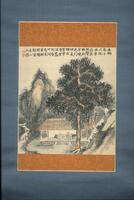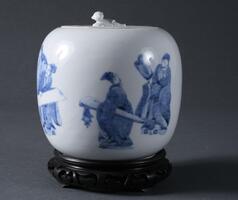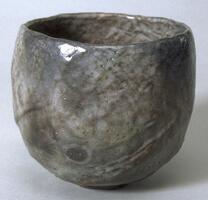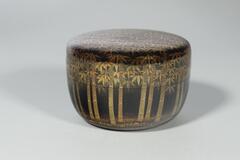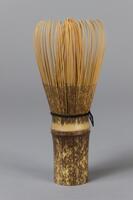A chance to think through how the visual impact of text, image, and text with image.
24 Items in this Learning Collection
Collection Object
Collection Object
Collection Object
Collection Object
Collection Object
Collection Object
Collection Object
Collection Object
Collection Object
Collection Object
Collection Object
Collection Object
Collection Object
Collection Object
Collection Object
Collection Object
Collection Object
Collection Object
Collection Object
Collection Object
Collection Object
Copyright
All Rights Reserved
()
And Naturally Ripens into Fruit
Accession Number
1968/2.19
Title
And Naturally Ripens into Fruit
Artist(s)
Tetsugen
Object Creation Date
circa 1660-1682
Medium & Support
ink on paper
Dimensions
4 ft. 4 1/4 in. x 10 7/16 in. (132.6 x 26.4 cm);3 x 19 5/8 x 3 1/4 in. (7.62 x 49.85 x 8.25 cm)
Credit Line
Museum purchase made possible by the Margaret Watson Parker Art Collection Fund
Label copy
In traditional China, calligraphy was regarded as the highest of the arts, for it was held to be the truest reflection of one’s character. To do calligraphy well required many years of disciplined practice and study of the great works of earlier masters. For Chinese and Japanese Zen monks, who absorbed much of Chinese literati culture, calligraphy could thus be a form of self-portraiture. Just as the disciples and lay followers of a prominent Zen teacher would request copies of his painted likeness, so also did they seek to obtain authentic samples of his writing. Hanging scrolls such as this one were produced by the thousands to satisfy this market. The inscriptions are meant to have edifying content; often, they quote from or allude to the Zenrin kushû, a well-known collection of Zen sayings. The verse here is the second line of a two-line poem, a verse piously attributed to Bodhidharma that seems to predict the future flourishing of the five lineages of Zen:
"One bud opens into five petals, and naturally ripens into fruit.*
The calligrapher of this scroll, Ôbaku Tetsugen, was among the first generation of Japanese converts to the Ôbaku sect of Zen. He was a disciple of Muan, whose calligraphy is seen just to the left. Tetsugen is perhaps the most beloved of the Ôbaku monks, for his selfless efforts to distribute inexpensively printed versions of the Buddhist scriptures and to organize aid to rural villagers during the great famine of 1682.
Arts of Zen, February 15-June 15, 2003
M. Graybill, Senior Curator of Asian Art
In traditional China, calligraphy was regarded as the highest of the arts because it was held to be the truest reflection of one’s character. To do calligraphy well required many years of disciplined practice and the study of the great works of earlier masters. For Chinese Chán and Japanese Zen monks, who were immersed in Chinese literati culture, calligraphy could thus be a form of self-portraiture. Just as the disciples and lay followers of a prominent Zen teacher would request painted copies of his likeness, so also did they seek to obtain authentic samples of his writing. Hanging scrolls such as this one were produced by the thousands to satisfy this market. The inscriptions were meant to have edifying content;
often they quote from or allude to the Zenrin kushû, a well-known collection of Zen sayings. The verse here, piously attributed to Bodhidharma, is the second of a two-line poem and seems to predict the future flourishing of the five lineages of Zen: “One bud opens into five petals, and naturally ripens into fruit.”
The calligrapher of this scroll, Ôbaku Tetsugen, was among the first generation of Japanese converts to the Ôbaku sect of Zen; he was a disciple of Muan Xingtao (known in Japan as Mokuan), whose calligraphy is also seen in the gallery. Tetsugen is perhaps the most beloved of the Ôbaku monks for his selfless efforts to distribute inexpensively printed versions of the Buddhist scriptures and to organize aid to rural villagers during the great famine of 1682.
Winter 2011 Gallery Rotation
Ôbaku Tetsugen
Japan, active 1630–1682
And Naturally Ripens into Fruit
circa 1660–1682
Edo Period (1615–1868)
Hanging scroll, ink on paper
Museum purchase made possible by the Margaret Watson Parker Art Collection Fund, 1968/2.19
In traditional China, calligraphy was regarded as the highest of the arts because it was held to be the truest reflection of one’s character. To do calligraphy well required many years of disciplined practice and the study of the great works of earlier masters. For Chinese Chán and Japanese Zen monks, who were immersed in Chinese literati culture, calligraphy could thus be a form of self-portraiture. Just as the disciples and lay followers of a prominent Zen teacher would request painted copies of his likeness, so also did they seek to obtain authentic samples of his writing. Hanging scrolls such as this one were produced by the thousands to satisfy this market. The inscriptions were meant to have edifying content;
often they quote from or allude to the Zenrin kushû, a well-known collection of Zen sayings. The verse here, piously attributed to Bodhidharma, is the second of a two-line poem and seems to predict the future flourishing of the five lineages of Zen: “One bud opens into five petals, and naturally ripens into fruit.”
The calligrapher of this scroll, Ôbaku Tetsugen, was among the first generation of Japanese converts to the Ôbaku sect of Zen; he was a disciple of Muan Xingtao (known in Japan as Mokuan), whose calligraphy is also seen in the gallery. Tetsugen is perhaps the most beloved of the Ôbaku monks for his selfless efforts to distribute inexpensively printed versions of the Buddhist scriptures and to organize aid to rural villagers during the great famine of 1682.
Subject matter
In traditional China, calligraphy was regarded as the highest of the arts because it was held to be the truest reflection of one’s character. For Chinese Chán and Japanese Zen monks, who were immersed in Chinese literati culture, calligraphy could thus be a form of self-portraiture.
The verse here, piously attributed to Bodhidharma, is the second of a two-line poem and seems to predict the future flourishing of the five lineages of Zen: “One bud opens into five petals, and naturally ripens into fruit.”
The calligrapher of this scroll, Ôbaku Tetsugen, was among the first generation of Japanese converts to the Ôbaku sect of Zen; he was a disciple of Muan Xingtao (known in Japan as Mokuan).
Physical Description
Hanging scroll with five large calligraphic kanji characters. The lower right contains further text and orangish read seals. The background brocade on which it is mounted is green and gold and has a floral design. Two strips of other material lie across the top and bottom of the white material on which teh calligraphy is painted. These strips also have a floral design and a light gold/yellow background.
Primary Object Classification
Painting
Primary Object Type
calligraphy
Additional Object Classification(s)
Painting
Collection Area
Asian
Rights
If you are interested in using an image for a publication, please visit http://umma.umich.edu/request-image for more information and to fill out the online Image Rights and Reproductions Request Form.
Keywords
Buddhism
Ch'an (religion)
Zen (Japanese Buddhism)
calligraphy (process)
fruit (plant components)
ink
1968/2.19
Title
And Naturally Ripens into Fruit
Artist(s)
Tetsugen
Object Creation Date
circa 1660-1682
Medium & Support
ink on paper
Dimensions
4 ft. 4 1/4 in. x 10 7/16 in. (132.6 x 26.4 cm);3 x 19 5/8 x 3 1/4 in. (7.62 x 49.85 x 8.25 cm)
Credit Line
Museum purchase made possible by the Margaret Watson Parker Art Collection Fund
Label copy
In traditional China, calligraphy was regarded as the highest of the arts, for it was held to be the truest reflection of one’s character. To do calligraphy well required many years of disciplined practice and study of the great works of earlier masters. For Chinese and Japanese Zen monks, who absorbed much of Chinese literati culture, calligraphy could thus be a form of self-portraiture. Just as the disciples and lay followers of a prominent Zen teacher would request copies of his painted likeness, so also did they seek to obtain authentic samples of his writing. Hanging scrolls such as this one were produced by the thousands to satisfy this market. The inscriptions are meant to have edifying content; often, they quote from or allude to the Zenrin kushû, a well-known collection of Zen sayings. The verse here is the second line of a two-line poem, a verse piously attributed to Bodhidharma that seems to predict the future flourishing of the five lineages of Zen:
"One bud opens into five petals, and naturally ripens into fruit.*
The calligrapher of this scroll, Ôbaku Tetsugen, was among the first generation of Japanese converts to the Ôbaku sect of Zen. He was a disciple of Muan, whose calligraphy is seen just to the left. Tetsugen is perhaps the most beloved of the Ôbaku monks, for his selfless efforts to distribute inexpensively printed versions of the Buddhist scriptures and to organize aid to rural villagers during the great famine of 1682.
Arts of Zen, February 15-June 15, 2003
M. Graybill, Senior Curator of Asian Art
In traditional China, calligraphy was regarded as the highest of the arts because it was held to be the truest reflection of one’s character. To do calligraphy well required many years of disciplined practice and the study of the great works of earlier masters. For Chinese Chán and Japanese Zen monks, who were immersed in Chinese literati culture, calligraphy could thus be a form of self-portraiture. Just as the disciples and lay followers of a prominent Zen teacher would request painted copies of his likeness, so also did they seek to obtain authentic samples of his writing. Hanging scrolls such as this one were produced by the thousands to satisfy this market. The inscriptions were meant to have edifying content;
often they quote from or allude to the Zenrin kushû, a well-known collection of Zen sayings. The verse here, piously attributed to Bodhidharma, is the second of a two-line poem and seems to predict the future flourishing of the five lineages of Zen: “One bud opens into five petals, and naturally ripens into fruit.”
The calligrapher of this scroll, Ôbaku Tetsugen, was among the first generation of Japanese converts to the Ôbaku sect of Zen; he was a disciple of Muan Xingtao (known in Japan as Mokuan), whose calligraphy is also seen in the gallery. Tetsugen is perhaps the most beloved of the Ôbaku monks for his selfless efforts to distribute inexpensively printed versions of the Buddhist scriptures and to organize aid to rural villagers during the great famine of 1682.
Winter 2011 Gallery Rotation
Ôbaku Tetsugen
Japan, active 1630–1682
And Naturally Ripens into Fruit
circa 1660–1682
Edo Period (1615–1868)
Hanging scroll, ink on paper
Museum purchase made possible by the Margaret Watson Parker Art Collection Fund, 1968/2.19
In traditional China, calligraphy was regarded as the highest of the arts because it was held to be the truest reflection of one’s character. To do calligraphy well required many years of disciplined practice and the study of the great works of earlier masters. For Chinese Chán and Japanese Zen monks, who were immersed in Chinese literati culture, calligraphy could thus be a form of self-portraiture. Just as the disciples and lay followers of a prominent Zen teacher would request painted copies of his likeness, so also did they seek to obtain authentic samples of his writing. Hanging scrolls such as this one were produced by the thousands to satisfy this market. The inscriptions were meant to have edifying content;
often they quote from or allude to the Zenrin kushû, a well-known collection of Zen sayings. The verse here, piously attributed to Bodhidharma, is the second of a two-line poem and seems to predict the future flourishing of the five lineages of Zen: “One bud opens into five petals, and naturally ripens into fruit.”
The calligrapher of this scroll, Ôbaku Tetsugen, was among the first generation of Japanese converts to the Ôbaku sect of Zen; he was a disciple of Muan Xingtao (known in Japan as Mokuan), whose calligraphy is also seen in the gallery. Tetsugen is perhaps the most beloved of the Ôbaku monks for his selfless efforts to distribute inexpensively printed versions of the Buddhist scriptures and to organize aid to rural villagers during the great famine of 1682.
Subject matter
In traditional China, calligraphy was regarded as the highest of the arts because it was held to be the truest reflection of one’s character. For Chinese Chán and Japanese Zen monks, who were immersed in Chinese literati culture, calligraphy could thus be a form of self-portraiture.
The verse here, piously attributed to Bodhidharma, is the second of a two-line poem and seems to predict the future flourishing of the five lineages of Zen: “One bud opens into five petals, and naturally ripens into fruit.”
The calligrapher of this scroll, Ôbaku Tetsugen, was among the first generation of Japanese converts to the Ôbaku sect of Zen; he was a disciple of Muan Xingtao (known in Japan as Mokuan).
Physical Description
Hanging scroll with five large calligraphic kanji characters. The lower right contains further text and orangish read seals. The background brocade on which it is mounted is green and gold and has a floral design. Two strips of other material lie across the top and bottom of the white material on which teh calligraphy is painted. These strips also have a floral design and a light gold/yellow background.
Primary Object Classification
Painting
Primary Object Type
calligraphy
Additional Object Classification(s)
Painting
Collection Area
Asian
Rights
If you are interested in using an image for a publication, please visit http://umma.umich.edu/request-image for more information and to fill out the online Image Rights and Reproductions Request Form.
Keywords
Buddhism
Ch'an (religion)
Zen (Japanese Buddhism)
calligraphy (process)
fruit (plant components)
ink
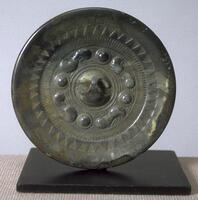
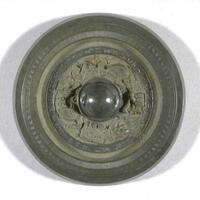






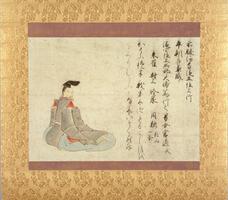
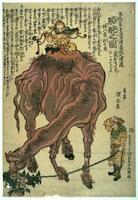

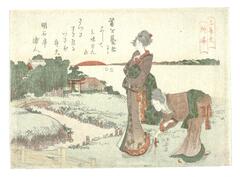
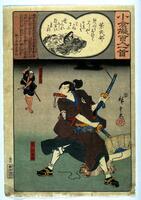



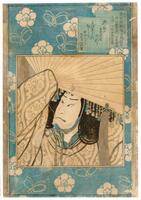
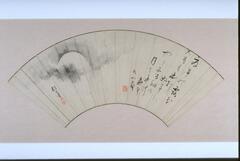

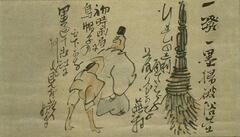

![In this monumental scroll, Nukina Kaioku has brushed a Chinese poem of his own composition, on the enduring theme of nature as refreshment for the spirit. Note his masterful variation of thick and thin strokes, wet and dry ink, stately and rapid movement.<br />The verses may be tentatively rendered into English as follows:<br /> Mandarin ducks enjoy the fresh water; their graceful forms glow as they pass through channels in the reeds.<br /> Pushing beyond the thickets [to the open pond], they call to one another again and again in the dawn.<br /> A crimson mist breaks through gaps in the glade, its glow warming hidden nests.<br /> Waking up with nothing to do, [I came here] to playfully row among the spring waves. In this monumental scroll, Nukina Kaioku has brushed a Chinese poem of his own composition, on the enduring theme of nature as refreshment for the spirit. Note his masterful variation of thick and thin strokes, wet and dry ink, stately and rapid movement.<br />The verses may be tentatively rendered into English as follows:<br /> Mandarin ducks enjoy the fresh water; their graceful forms glow as they pass through channels in the reeds.<br /> Pushing beyond the thickets [to the open pond], they call to one another again and again in the dawn.<br /> A crimson mist breaks through gaps in the glade, its glow warming hidden nests.<br /> Waking up with nothing to do, [I came here] to playfully row among the spring waves.](/media/W1siZiIsIjIwMjIvMDUvMjUvNDA4bXZmMmt5bF9kZWZhdWx0LmpwZyJdLFsicCIsInRodW1iIiwiMjQweDIwMCJdXQ?sha=1fda6bad9ec42b3f)


